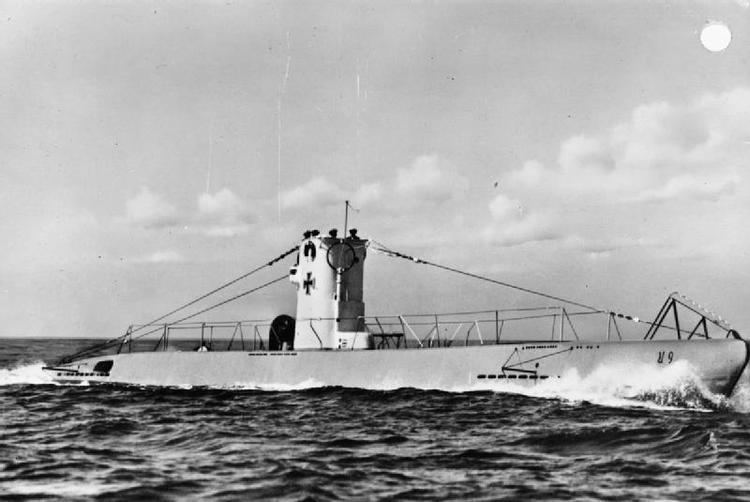Name U-21 Height 8.60 m (28 ft 3 in) Launched 31 July 1936 Draft 3.9 m | Class and type IIB coastal submarine Construction started 4 March 1935 Length 43 m | |
 | ||
Fate Stranded, March 1940 after running aground in southern Norway Beam 4.08 m (13 ft 5 in) (o/a)4.00 m (13 ft 1 in) (pressure hull) Builders Friedrich Krupp Germaniawerft, Howaldtswerke-Deutsche Werft Part of | ||
German submarine U-21 was a Type IIB U-boat of Nazi Germany's Kriegsmarine. Her keel was laid down 4 March 1936, by Germaniawerft of Kiel as yard number 551. She was commissioned on 3 August 1936. During World War II, she conducted operations against enemy shipping.
Contents
U-21 went on seven war patrols, sinking five ships, one auxiliary warship and damaging one warship.
Design
German Type IIB submarines were enlarged versions of the original Type IIs. U-21 had a displacement of 279 tonnes (275 long tons) when at the surface and 328 tonnes (323 long tons) while submerged. Officially, the standard tonnage was 250 long tons (250 t), however. The U-boat had a total length of 42.70 m (140 ft 1 in), a pressure hull length of 28.20 m (92 ft 6 in), a beam of 4.08 m (13 ft 5 in), a height of 8.60 m (28 ft 3 in), and a draught of 3.90 m (12 ft 10 in). The submarine was powered by two MWM RS 127 S four-stroke, six-cylinder diesel engines of 700 metric horsepower (510 kW; 690 shp) for cruising, two Siemens-Schuckert PG VV 322/36 double-acting electric motors producing a total of 460 metric horsepower (340 kW; 450 shp) for use while submerged. She had two shafts and two 0.85 m (3 ft) propellers. The boat was capable of operating at depths of up to 80–150 metres (260–490 ft).
The submarine had a maximum surface speed of 12 knots (22 km/h; 14 mph) and a maximum submerged speed of 7 knots (13 km/h; 8.1 mph). When submerged, the boat could operate for 35–42 nautical miles (65–78 km; 40–48 mi) at 4 knots (7.4 km/h; 4.6 mph); when surfaced, she could travel 3,800 nautical miles (7,000 km; 4,400 mi) at 8 knots (15 km/h; 9.2 mph). U-21 was fitted with three 53.3 cm (21 in) torpedo tubes at the bow, five torpedoes or up to twelve Type A torpedo mines, and a 2 cm (0.79 in) anti-aircraft gun. The boat had a complement of twentyfive.
1st, 2nd and 3rd patrols
U-21's first patrol was relatively uneventful.
On her second foray, the boat was attacked by the British submarine HMS Ursulawhich fired six torpedoes at her in the North Sea northeast of Berwick-Upon-Tweed [On the English/Scottish border] on 17 September 1939. These were the first submarine weapons launched by the Royal Navy in the Second World War. They all missed.
On her third patrol, the U-boat also had torpedoes fired at her in the central North Sea by another British submarine, HMS Sealion. The result was inconclusive as well.
4th and 5th patrols
The boat's first success with a torpedo came on 1 December 1939 when she sank the Finnish-registered Mercator about 12 nmi (22 km; 14 mi) southeast of Buchan Ness (near Peterhead). She also damaged the British cruiser HMS Belfast with a mine.
On her fifth sortie, she sank Mars on 21 December 1939 and Carl Henckel (both from Sweden), on the same day. She also sank the British boom defence vessel HMS Bayonet in the Firth of Forth, again with a mine.
6th patrol
Patrol number six saw her sink the Danish Vidar 100 nmi (190 km; 120 mi) east of the Moray Firth on 31 January 1940.
7th patrol
She sank the British Royal Archer with a mine on 26 February 1940, but then it all went horribly wrong on 27 March when she ran aground off Oldknuppen Island after a navigational error. The boat was towed to Mandal in Norway where she was interned. She was then towed to Kristiansand for repairs and released on 9 April after the German occupation of the Nordic country.
Fate
In July she was transferred to the 21st U-boat Flotilla in Kiel as a training boat, with whom she remained for the rest of the war. U-21 was scrapped in February 1945.
